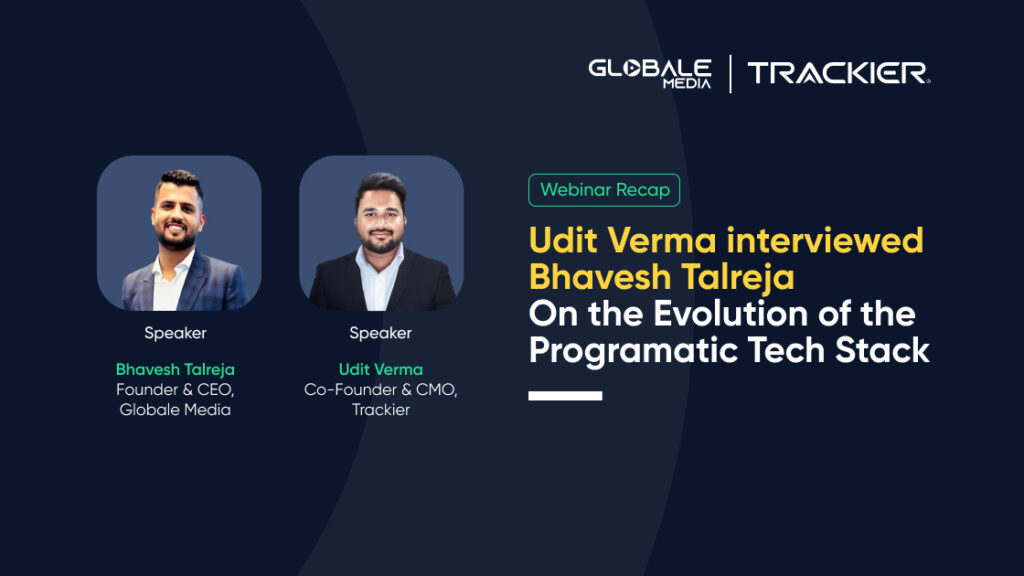Decoding the Evolution of the Programmatic Stack
As the marketing landscape rapidly shifts toward privacy, personalization, and platform interoperability, one question looms large: Are DSPs (Demand-Side Platforms) becoming obsolete? In a recent discussion between Udit Verma and Bhavesh Talreja, Founder of Globale Media, this pressing question was explored in depth, offering a sharp look at how programmatic technology is evolving—and what it means for brands navigating the future of digital advertising.

The Shifting Role of DSPs in a Privacy-First Era
DSPs have long been a cornerstone of programmatic media buying, enabling automated, real-time bidding across ad exchanges. But as Bhavesh pointed out, the dominance of DSPs is being challenged—not because their utility is fading, but because the way brands use them is evolving.
Today, brands are becoming increasingly data-centric and channel-agnostic. With growing investments in first-party data infrastructure, many brands are asking: Can we do more in-house? The answer, as the panel revealed, isn’t about replacing DSPs but repositioning them within a hybrid strategy that gives brands more control and agility.
First-Party Data: The Core of the Modern Martech Stack
A key driver of change is the shift from third-party to first-party data. With tighter data regulations (GDPR, CCPA) and platform changes like Apple’s ATT and Google’s Privacy Sandbox, brands now rely heavily on data they collect directly from their users.
Bhavesh emphasized the importance of building a rigid, well-integrated CRM-CDP stack that flows seamlessly across touchpoints—from CRM to attribution tools to DSPs and back. This interconnected loop enables real-time user tracking, intent prediction, and campaign personalization at scale.
The takeaway? DSPs still matter—but they must plug into a smarter, consent-first ecosystem rather than operate in isolation.
Predictive Signals and AI-Driven Campaign Logic
With strong first-party data foundations, brands can leverage AI to power predictive marketing. For example, when a user drops off after adding a product to cart, an AI model can predict their likelihood to convert and trigger a dynamic offer in real time. This kind of responsiveness was once reliant on DSPs; now, it’s increasingly driven by CRM + CDP + automation layers.
That doesn’t render DSPs obsolete—but it does redefine their role. They become execution engines, not strategic drivers.
Vertical-Specific Shifts in the Programmatic Landscape
Different industries are rethinking their programmatic strategy based on the maturity of their data and regulations:
- Ecommerce is laser-focused on lifetime value (LTV) and omnichannel attribution. From website interactions to Instagram retargeting, the goal is to personalize offers and content based on user behavior across platforms.
- Gaming brands are embracing rewarded video and incentive-based advertising. Their growth often peaks during key events (e.g., IPL) and relies heavily on behavioral targeting and creative iteration.
- Fintech, facing regulatory scrutiny, requires precision marketing. The goal isn’t just app installs—it’s verified, compliant user acquisition. Here, DSPs must align tightly with CRM data and ensure full transparency.
In all cases, DSPs are no longer the first line of growth—they’re a layer in a more complex performance stack.
The Rise of the Hybrid Media Buying Model
One of the most insightful takeaways from the conversation was the importance of hybrid media strategies. Brands today want the best of both worlds: strategic in-housing for data and planning, and specialized agency support for execution and scale.
As Bhavesh noted, even when brands bring media buying in-house, they often still rely on agencies for deep expertise, access to premium inventory, influencer collaborations, and DSP optimization.
This hybrid model also allows brands to blend performance channels (Meta, Google, programmatic DSPs) with broader awareness campaigns—OTT, influencer, OOH—to create a full-funnel growth engine.
Are Agencies and DSPs Still Relevant? Yes—But Evolving Fast
With increasing demand for transparency and control, agencies are also transforming. Many now offer white-labeled DSP dashboards, first-party audience segmentation, and real-time reporting as part of their core offerings. The goal is no longer just buying impressions, but becoming strategic martech enablers.
For DSPs, survival depends on how well they integrate with a brand’s existing data stack and contribute to user-level optimization. In this future, DSPs aren’t dying—they’re becoming more embedded, contextual, and purpose-driven.
Conclusion: DSPs Are Not Obsolete, But Their Role Has Changed
So—will DSPs become obsolete? The answer is a resounding no, but their standalone dominance is over. In a world where first-party data, predictive analytics, and cross-platform orchestration drive performance, DSPs are one piece of a much larger puzzle.
Brands that succeed will be those who treat their data architecture as a strategic asset and who build flexible, transparent marketing stacks where DSPs, CRM systems, CDPs, and automation platforms work in harmony.
The future isn’t about dismantling the programmatic stack—it’s about rearchitecting it to serve the customer, the channel, and the moment with precision.




